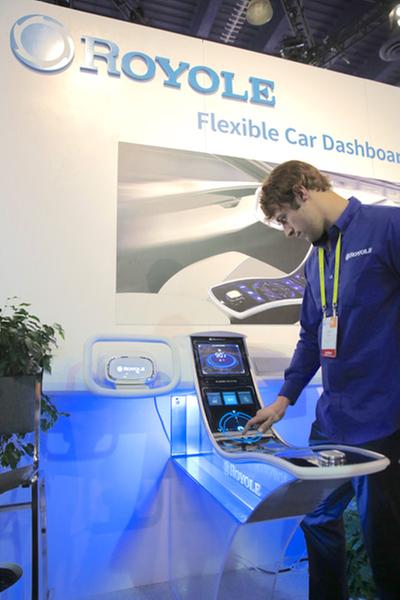Top Ten Black Technologies list revealed
By Chen Meiling in Guiyang | chinadaily.com.cn | Updated: 2017-05-28 11:24
 |
| A man touches a flexible display at the 2017 China International Big Data Expo in Guiyang, capital of Southwest China's Guizhou province. [Photo/chinadaily.com.cn] |
A Top Ten Black Technologies list has been released at the 2017 China International Big Data Expo in Guiyang, capital of Southwest China's Guizhou province, stating how innovating the data industry helped to build a stronger, more intelligent life.
Ma Fang, senior media relations manager of Shenzhen-based Royole Corporation, said the structure and 0.01 micrometers of flexible display, seen at the event, can be applied to mobile phones, tablets, personal computers, smart home devices and intelligent transportation systems.
Much like the model, the flexible keyboard, released and featured at the event last year, was transparent, light and thin. It could expand and downsize into a stick no larger than a pen, which was easy for journalists to write stories everywhere, Ma said.
"The mobile phone, which can be worn on the wrist, was also released in the United States in January," she said.
"The display will go into production by the end of 2017, and has an estimated annual output of 20 billion yuan."
Ma added the company, Shenzhen-based Royole Corporation, recently signed a cooperation memorandum with China Southern Airlines and Shenzhen Bus, as an application of flexible materials in the aviation and automobile industries.
"There will be no buttons on the operating desk because orders of playing music, guiding roads or air conditioning can be given through touch control," she said.
Wang Hongan, software researcher of the China Academy of Sciences, added the black technology referred to innovative high technology, which was developed generally beyond common sense, and said it would potentially overturn the whole industry.
"The 3D commodity show of the JD Group was enrolled in due to the application of the augmented reality technology in its e-commerce platform," he said.
According to Zhao Gang, leader of visual and augmented reality business of JD, the image of a rice cooker could also be put into real-life circumstances, in order to see if a chosen color and size would suit a specific kitchen.
"Some online shop owners may beautify products, but the 3D technology can even help customers to its inside; which, thus, helps them to make decisions," he said.
Sun Xuhong, director of central air conditioner of Haier, said a driverless unmanned air conditioner, from the Haier Group, had also been significantly developed to detect the temperature of nearby people and could adjust itself.
"The unmanned control system, called Haier intelligent cloud, can design different operating process for companies due to the mass data collected from various industries," he said.
A big data service start-up in China, named Hydata, also developed lip-reading recognition technology, which featured a 70 percent accuracy rate for the Chinese language. It also had an 80 percent accuracy rate for the English language, and was on the way of industrialization, with public security departments, in some provinces.
The technological framework of human-machine emotional interference – put forward by the Chinese Academy of Sciences, the China Electronics Standardization Institute and Guizhou Xiao I Robot Technology Co in February – won the title of black technology in the artificial intelligence field at the 2017 China International Big Data Expo.
"In the future, we expect to make robots which will be able to learn the emotions of humans, just by taking part in fluent and natural conversations," Wang Hao, CTO of Xiao I Robot, said.
"The technology could be used in customer service, as well as looking into the early diagnosis of mental disease, and personalized online learning courses."
A representative, and organizer, of the 2017 China International Big Data Expo added the awards were selected from products and services reported from the media worldwide, which were recommended by universities, based in China, and exhibitors at the expo.
























